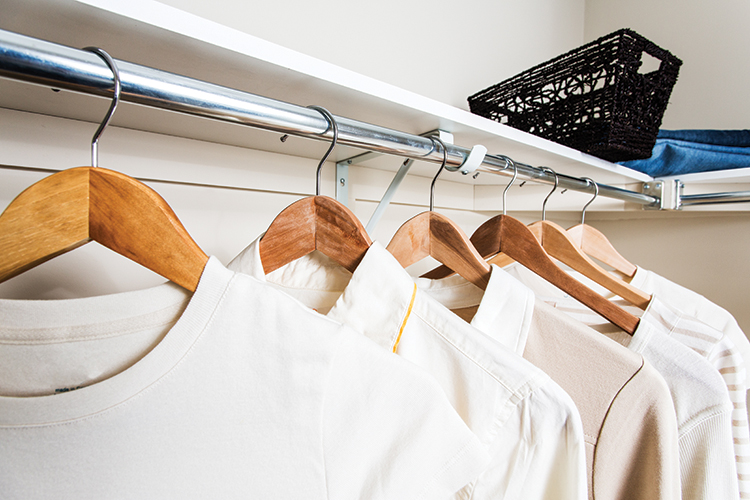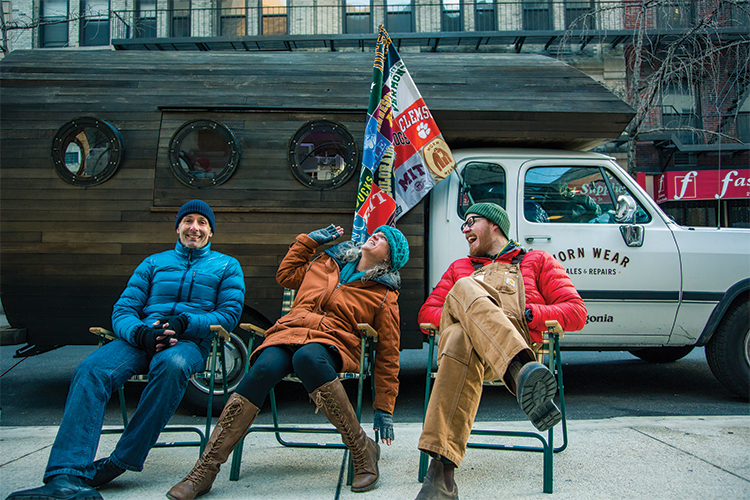Creating a capsule wardrobe can help support everything from reduced waste to women’s rights
By Brittany Barbato
After years of budget-shopping for work clothes at Salvation Army and Goodwill, I looked into the mix-and-match jungle in my closet one morning and thought: I have nothing to wear.
I decided I needed to purge. Clothes flew left and right as I tugged them off the hangers and tossed them into a designated “giveaway” pile. But soon my decisive actions were derailed by other thoughts: Cousin Liz gave this to me for Christmas, and I’d hurt her feelings if I donated it… I never wear this skirt, but it finally fits me so shouldn’t I keep it just in case?… I can’t get rid of this; it was an amazing thrift shop find three years ago!
If I wanted to move toward a more minimalist wardrobe, I was going to need some help.
A simple Google search yielded hundreds of guides for decluttering a closet gone awry, but the most recommended step was a “capsule wardrobe.” The concept is simple: Create a compact set of color-coordinated staple pieces for regular wear. The number to hit, including shoes, seemed to be 30 pieces, and—at the extremes—some fashionistas suggest as few as 12 or as many as 100 items.
According to Donna Karan, to whom we can trace the origin of the American capsule, the lucky number is seven: In 1985, Karan unveiled her radical collection “Seven Easy Pieces.” She believed women could effortlessly assemble whatever outfit they needed with just a bodysuit, tights, a versatile skirt, a pair of trousers, a tailored jacket, a cashmere sweater and a white shirt. A few years later, she would follow her breakout capsule with a menswear-inspired pinstripe suit. Advertised through a campaign called In Women We Trust, the suit was featured in an eight-page spread that led with a photo of the first woman president in America being sworn into office. Disappointingly, the designer’s efforts to empower women were contradicted in October, when she spoke out in support of Harvey Weinstein after a deluge of sexual assault and harassment accusations against him. Complicitness in the context of capitalism is how the fashion industry got itself in trouble in the first place.
In the early 2000s, new online shopping channels drove demand for clothes to an all-time high. We saw the dawn of fast fashion: low-cost clothing that mimics current, high-cost luxury trends. In 2003, the first ever “high-low” collaboration was created as high-end designer Isaac Mizrahi signed a deal with Target for a small collection of core garments made accessible to the “everyday shopper.” Partnerships like Vera Wang for Kohl’s and the Kardashian sisters for Sears followed suit.
The spike in demand and expansion of access, paired with a rapid growth in technology, propelled retailers to design, manufacture and ship products much faster. “At one time, the fashion industry worked around a two-season calendar that unfolded at a predictable pace,” said Jim Zarroli on a 2013 episode of NPR’s “All Things Considered.” “A relentless drive for speed now characterizes the industry.”
But the issue is beyond speed: It’s money and greed at the expense of others and the environment. In order to keep costs low, brands moved their manufacturing abroad to take advantage of lower product development and labor costs. Lower sticker prices for consumers resulted in a higher volume of purchases and, in turn, meant consumers were turning over clothes much faster.
It’s no wonder so many of us have closets filled with clothes that aren’t meant to last. As I discovered the ramifications of fast fashion—waste, pollution and dangerous working conditions—I waged a second war on my wardrobe.
Fifty pieces, and peace of mind
When I got serious about creating a capsule wardrobe, I set an ambitious goal to cut my 103 items in half, and I again sorted everything into “keep” and “donate” bins. Afterward, I made a short list of a few staple pieces to purchase as replacements and developed my own multifaceted criteria for quality.
What exactly does “quality” mean? Could I afford it? The more I thought about it, the more it became clear the world can’t afford anything less. I committed to only buying well-made items—timeless pieces that would survive both wear and tear as well as the next big trend—and only items whose provenance and impact I could trace.
Criterion No. 1: My clothes must be timeless and wearable for multiple years. Fashion waste—or, clothes tossed into the trash—is directly contributing to the environmental crisis. According to Newsweek, in less than 20 years, the volume of clothing Americans throw away each year has doubled from 7 million to 14 million tons, or 80 pounds per person. We’re buying more clothes, wearing them less and disposing of them faster than ever. If we diverted these textiles into a recycling program instead, the Environmental Protection Agency estimates that it would be the equivalent of taking 7.3 million cars and their carbon dioxide emissions off the road. Donate or consign your clothes? Guess what: Supply far exceeds the need. According to Newsweek, charities are struggling to keep up with the sheer amount of donations and, because clothing quality is lower, other countries don’t want them either.
Criterion No. 2: My clothes need to be made of sustainable materials causing as little environmental harm as possible. With an estimated annual world production of more than 80 billion pieces of clothing, the fashion industry consumes a massive amount of natural resources. According to Greenpeace, clothing contributes about 3 percent of global production CO2 emissions, or more than 850 million tons of CO2 a year due to the immense amount of manufacturing, logistics and usage such as washing, drying and ironing. To make one T-shirt, it takes approximately 700 gallons of water—or, the average amount of water a person could drink for nearly two and a half years. Water contamination is another byproduct of the increase in clothing consumption. The dyeing process, in particular, uses more than 1.7 million tons of chemicals. These include perfluorinated chemicals (PFCs), which are toxic compounds widely used to make everyday products more resistant to stains as well as repellant to water.
Criterion No. 3: My clothes need to support the safety and economic mobility of others. An astonishing number of companies don’t know what goes on during each step of their production process, or, even worse, they know and don’t care. One of the most alarming developments in the clothing industry is related to women’s rights. According to Remake, a nonprofit that shares fashion workers’ stories to promote change, 75 million people work to make our clothes and 80 percent of them are women between the ages of 18 and 24. Approximately 100 pairs of hands touch our clothes before we see them in the store, and yet many of these individuals earn less than $3 per day. Factory environments are equally cheap, exposing workers to dangerous machinery, hazardous fumes and predatory management.
A runway to a better world
As my personal philosophy coalesced, I discovered fashion brands whose principles didn’t align with mine and some that did.
While brands such as H&M and Zara make headlines for offering opportunities to recycle old clothes, these efforts aren’t even close to enough, as they perpetuate a culture of throwaway clothing that benefits their bottom line. But Patagonia, for example, is a longtime leader in sustainable business practices. There are many local companies, such as United By Blue, that are working hard to align themselves in the same effort. Until more businesses evolve, the power for change is in our hands as consumers.
When we purchase less overall, then we can afford to save up and
spend our money on higher-quality pieces. This type of quality means so much more than the fabric we wear: It means we reject the idea that money is more important than each other and our planet. It means we can change the life of a 15-year-old girl living in Bangladesh. It means there doesn’t need to be conflict of interest between fashion and life. They can coexist.
Today, my capsule wardrobe and I are still a work in progress. I met my goal and currently own 52 pieces of clothing, including several new purchases selected through my criteria.
Although it may not be so visible on the outside, I know that what I’m wearing is making a statement—and a difference.









